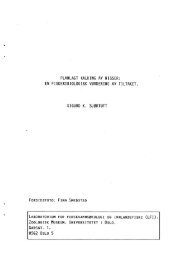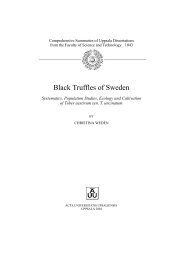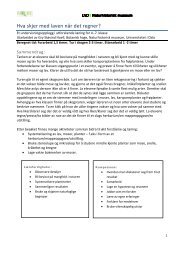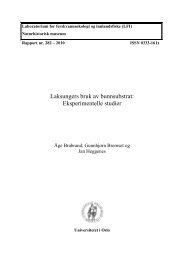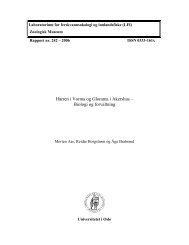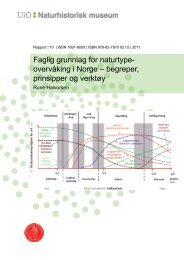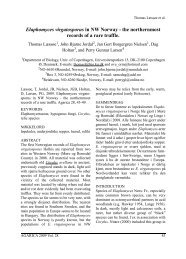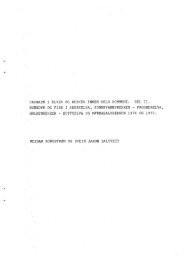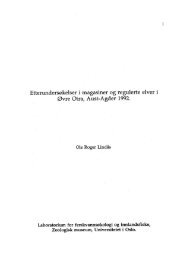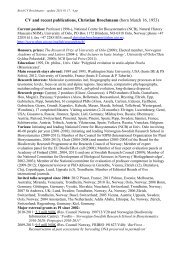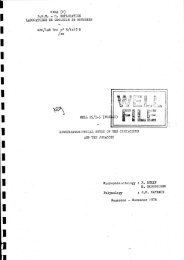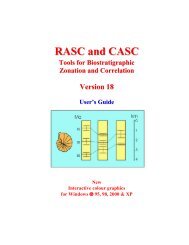Truffle trouble: what happened to the Tuberales?
Truffle trouble: what happened to the Tuberales?
Truffle trouble: what happened to the Tuberales?
- TAGS
- truffle
- www.nhm.uio.no
You also want an ePaper? Increase the reach of your titles
YUMPU automatically turns print PDFs into web optimized ePapers that Google loves.
1098 T. Læssøe, K. Hansen<br />
Landvik S, Kristiansen R, Schumacher T, 1998. Phylogenetic and<br />
structural studies in <strong>the</strong> Thelebolaceae (Ascomycota). Mycoscience<br />
39: 49–56.<br />
Landvik S, Shailer NFJ, Eriksson OE, 1996. SSU rDNA sequence<br />
support for a close relationship between <strong>the</strong> Elaphomycetales<br />
and <strong>the</strong> Eurotiales and Onygenales. Mycoscience 37:<br />
237–241.<br />
Lange M, 1956. Danish hypogeous macromycetes. Dansk Botanisk<br />
Arkiv 16: 1–84.<br />
Lawrynowicz M, 1988. Workowce (Ascomycetes), Jeleniakowe<br />
(Elaphomycetales), Truflowe (<strong>Tuberales</strong>). In: Grzyby (Mycota) Vol 18.<br />
PanstwoweWydawnictwo Naukowe, Warszawa-Kraków.<br />
Lawrynowicz M, 1991 [1989–90]. Chorology of European<br />
hypogeous ascomycetes. II. <strong>Tuberales</strong>. Acta Mycologici 26:<br />
7–75.<br />
Li L-T, 1997. Ultrastructural studies of Leucangium carthusianum<br />
(hypogeous Pezizales). International Journal of Plant Sciences 158:<br />
189–197.<br />
Li L-T, Kimbrough JW, 1994. Ultrastructural evidence for a relationship<br />
of <strong>the</strong> truffle genus Genea <strong>to</strong> Otideaceae (Pezizales).<br />
International Journal of Plant Sciences 155: 235–243.<br />
Li L-T, Kimbrough JW, 1995. Septal ultrastructure in three species<br />
of Tuber (hypogeous Pezizales). International Journal of Plant<br />
Sciences 156: 849–856.<br />
Maire RCJE, 1906. Notes mycologiques. Annales Mycologici 4: 329–<br />
335 1 fig.<br />
Malençon G, 1938. Les truffes européennes. His<strong>to</strong>rique, morphogénie,<br />
organographie, classification, culture. Revue Mycologique<br />
3 ((N.S.) Méacutem 1): 1–92.<br />
Malençon G, 1973. Champignons hypogés du nord de l’Afrique. I.<br />
Ascomycétes. Persoonia 7: 261–288.<br />
Marasas WFO, Trappe JM, 1973. Notes on sou<strong>the</strong>rn African<br />
<strong>Tuberales</strong>. Bothalia 11: 139–141.<br />
Marin AB, Libbey LM, Morgan ME, 1984. <strong>Truffle</strong>s: on <strong>the</strong> scent of<br />
a buried treasure. Mclilvainea 6: 34–38.<br />
Maser C, Trappe JM, Nussbaum RA, 1978. Fungal–small mammal<br />
interrelationships with emphasis on Oregon coniferous forests.<br />
Ecology 59: 799–809.<br />
Mattirolo O, 1928. Secondo elenco dei ‘funghi ipogaei’ raccolti<br />
nelle foreste di Vallombrosa (1900–1926). Nuovo Giornale Botanico<br />
Italiano 34: 1343–1358.<br />
Mello A, Murat C, Vizzini A, Gavazza V, Bonfante P, 2005. Tuber<br />
magnatum Pico, a species of limited geographical distribution:<br />
its genetic diversity inside and outside a truffle ground. Environmental<br />
Microbiology 7: 55–65.<br />
Mello A, Vizzini A, Longa<strong>to</strong> S, Rollo F, Bonfante P, Trappe JM, 2000.<br />
Tuber borchii versus Tuber maculatum: neotype studies and DNA<br />
analyses. Mycologia 92: 326–331.<br />
Miller SL, Torres P, McClean TM, 1994. Persistence of basidiospores<br />
and sclerotia of ec<strong>to</strong>mycorrhizal fungi and Morchella in<br />
soil. Mycologia 86: 89–95.<br />
Montecchi A, Lazzari G, 1993. Atlante Fo<strong>to</strong>grafico di Funghi Ipogei.<br />
Associazione Micologica Bresadola, Tren<strong>to</strong>.<br />
Montecchi A, Sarasini M, 2000. Funghi Ipogei d’Europa. Associazione<br />
Micologica Bresadola, Fondazione Centro Studi Micologici,<br />
Tren<strong>to</strong>.<br />
Moreno G, Déz J, Manjón JL, 2000. Picoa lefebvrei and Tirmania nivea,<br />
two rare hypogeous fungi from Spain. Mycological Research 104:<br />
378–381.<br />
Nannfeldt JA, 1946. En ny svensk hypogé, tryffeln Geopora schackii<br />
P. Henn [A new Swedish hypogeous fungus, Geopora schackii<br />
P. Henn.]. Friesia 3: 177–188.<br />
Norman JE, Egger KN, 1999. Molecular phylogenetic analysis of<br />
Peziza and related genera. Mycologia 91: 820–829.<br />
Nylander JAA, 2004. MrModeltest 2.2 Program distributed by <strong>the</strong><br />
author. Evolutionary Biology Centre, Uppsala University.<br />
O’Donnell K, Cigelnik E, Weber NS, Trappe JM, 1997. Phylogenetic<br />
relationships among ascomyce<strong>to</strong>us truffles and <strong>the</strong> true and<br />
false morels inferred from 18S and 28S ribosomal DNA<br />
sequence analysis. Mycologia 89: 48–65.<br />
Pacioni G, Bellina-Agostinone C, D’An<strong>to</strong>nio M, 1990. Odour<br />
composition of <strong>the</strong> Tuber melanosporum complex. Mycological<br />
Research 94: 201–204.<br />
Pacioni G, Comandini O, 1999. Tuber. In: Cairney JWG,<br />
Chambers SM (eds), Ec<strong>to</strong>mycorrhizal Fungi. Key Genera in Profile.<br />
Springer Verlag, Berlin, pp. 163–186.<br />
Palfner G, Agerer R, 1998a. Balsamia alba Harkness þ Pinus jeffreyi<br />
Grev. & Balf. Descriptions of Ec<strong>to</strong>mycorrhizae 3: 1–6.<br />
Palfner G, Agerer R, 1998b. Leucangium carthusianum (Tul.) Paol.<br />
(¼ Picoa carthusiana Tul. & Tul.) þ Pseudotsuga menziesii (Mirb.)<br />
Franco. Descriptions of Ec<strong>to</strong>mycorrhizae 3: 37–42.<br />
Parguey-Leduc A, Janex-Favre MC, Montant C, 1987a. Formation<br />
et evolution des ascospores de Tuber melanosporum (Truffe<br />
noire du Périgord, Discomycètes). Canadian Journal of Botany 65:<br />
1491–1503.<br />
Parguey-Leduc A, Janex-Favre MC, Montant C, 1990. L’appareil<br />
sporophytique et les asques du Tuber melanosporum Vitt.<br />
(Truffe noire du Périgord, Discomycètes). Cryp<strong>to</strong>gamie Mycologie<br />
11: 47–68.<br />
Parguey-Leduc A, Montant C, Kulifaj M, 1987b. Morphologie et<br />
structure de l’ascocarpe adulte du Tuber melanosporum Vitt.<br />
(Truffe noire du Périgord, Discomycetes). Cryp<strong>to</strong>gamie. Mycologie<br />
8: 173–202.<br />
Pa<strong>to</strong>uillard N, 1903. Note sur le genre Paurocotylis Berk. Bulletin de<br />
la Société de Mycologique de France 19: 339–341.<br />
Pegler DN, Spooner BM, Young TWK, 1993. British <strong>Truffle</strong>s.<br />
A Revision of British Hypogeous Fungi. Royal Botanic Gardens,<br />
Kew.<br />
Percudani R, Trevisi A, Zambonelli A, Ot<strong>to</strong>nello S, 1999. Molecular<br />
phylogeny of truffles (Pezizales: Terfeziaceae, Tuberaceae) derived<br />
from nuclear rDNA sequence analysis. Molecular Phylogenetics<br />
and Evolution 13: 169–180.<br />
Perry BA, Hansen K, Pfister DH, 2007. A phylogenetic overview of<br />
<strong>the</strong> family Pyronemataceae (Ascomycota, Pezizales). Mycological<br />
Research 111: 549–571. doi: 10.1016/j.mycres.2007.03.014.<br />
Pfister D, 1984. Genea–Jafneadelphus d a tuberalean–pezizalean<br />
connection. Mycologia 76: 170–172.<br />
Rauscher T, Agerer R, Chevalier G, 1995. Ek<strong>to</strong>mykorrhizen<br />
von Tuber melanosporum, Tuber mesentericum und Tuber<br />
rufum (<strong>Tuberales</strong>) an Corylus avellana. Nova Hedwigia 61:<br />
281–322.<br />
Roux C, Sejalon-Delmas N, Martins M, Parguey-Leduc A,<br />
Dargent R, Becard G, 1999. Phylogenetic relationships between<br />
European and Chinese truffles based on parsimony and<br />
distance analysis of ITS sequences. FEMS Microbiology Letters<br />
180: 147–155.<br />
Senn-Irlet B, Aeberhard H, 2005. Der Pilz des Monats (5). Hydnocystis<br />
piligera Tulasne et C. Tulasne 1844. Schweizerische Zeitschrift<br />
für Pilzkunde 83: 98–103.<br />
Shimodaira H, Hasegawa M, 1999. Multiple comparisons of<br />
log-likelihoods with applications <strong>to</strong> phylogenetic inference.<br />
Molecular Biology and Evolution 16: 1114–1116.<br />
Singer R, 1961. Mushrooms and <strong>Truffle</strong>s. Botany, Cultivation, and<br />
Utilization. Interscience Publications, London.<br />
Smith ME, Trappe JM, Rizzo DM, 2006. Genea, Genabea and Gilkeya<br />
gen. nov.: ascomata and ec<strong>to</strong>mycorrhiza formation in a<br />
Quercus woodland. Mycologia 98: 699–716.<br />
Swofford DL, 2002. PAUP*. Phylogenetic analysis using parsimony<br />
(*and o<strong>the</strong>r methods). Version 4. Sinauer Associates, Sunderland,<br />
MA.<br />
Szemere L, 1965. Die Unterirdischen Pilze des Karpatenbeckens, fungi<br />
hypogaei terri<strong>to</strong>rii Carpa<strong>to</strong>-Pannonici. Académiai Kiadó,<br />
Budapest.<br />
Taylor FW, Thamage DM, Baker N, Roth-Bejerano N, Kagan-Zur V,<br />
1995. Notes on <strong>the</strong> Kalahari Desert truffle, Terfezia pfeilii.<br />
Mycological Research 99: 874–878.



